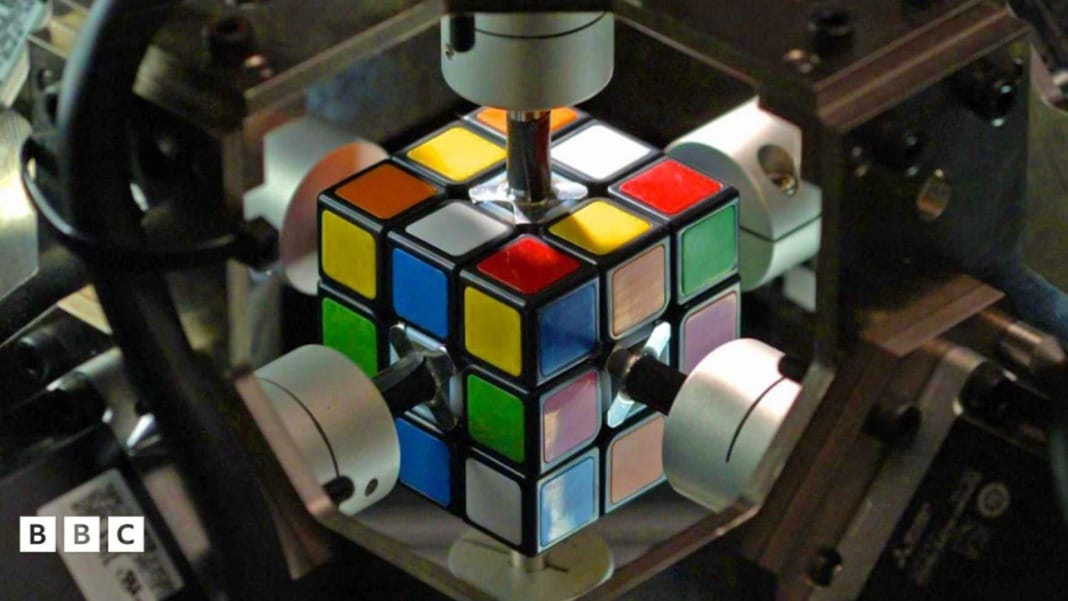A group of students from Purdue University has built the fastest Rubik’s Cube-solving robot ever recorded. Their robot, named Purdubik’s Cube, cracked the colourful cube in just 0.103 seconds — nearly three times faster than the previous world record set by Mitsubishi Electric in Japan last May.
If you’re wondering how that’s possible, the secret wasn’t just making the robot faster. The students used clever tricks, customised parts, and expert-level solving methods to bring this record to life. Guinness World Records have officially recognised their innovation.
How it all began
The race to build the world’s fastest cube-solving robot started in 2014, when Cubestormer 3, made from LEGO Mindstorms and powered by a Samsung Galaxy S4, solved the puzzle in 3.253 seconds. At the time, it was faster than any human could manage.
Today, the human world record stands at 3.05 seconds, set by Xuanyi Geng. But robot records have gotten much faster — dropping from seconds to milliseconds over the last decade.
Purdue’s team — comprised of Junpei Ota, Aden Hurd, Matthew Patrohay, and Alex Berta from the Elmore Family School of Electrical and Computer Engineering — knew they had to go beyond just adding stronger motors. “Each record focused on one new thing,” explained Patrohay. “We had to do several things differently all at once.”
Speed from every angle
One of the most important parts of solving a Rubik’s Cube fast is seeing how it’s scrambled. Unlike humans, who get time to look at the cube before starting, robots must include this scanning time in their final result. So, the Purdue team upgraded this part first.
They used two small but powerful cameras placed at opposite corners of the cube. These cameras needed to take pictures of only three sides each to see all six. They captured images in just 10 microseconds and cropped the view to focus only on a tiny 128×124-pixel space, so they didn’t waste time processing large images.
Even better, they skipped full image processing entirely. Instead of turning the camera’s view into full pictures, the robot reads raw data straight from the sensor and sends it directly to a colour detection system. This system checks small sample spots on each square to tell what colour it is — faster than even some AI methods.
“It’s not always perfect,” Patrohay admitted, “but even if it’s right 90% of the time, that’s fast enough.”
Clever tricks and a tough cube
While most of the hardware was custom-built, the team used an existing solver algorithm, Rob-Twophase, by Elias Frantar. This system is designed for robots and allows moves like turning two sides simultaneously, which people can’t do.
They also used a trick called “corner cutting.” This lets one side of the cube begin turning before the last one finishes — a move that saves time but risks breaking the cube. To ensure their cube could handle the pressure, the students had to redesign it entirely.
The rules allow you to modify the cube if it behaves like a standard Rubik’s Cube. So, they 3D-printed a new one using strong SLS nylon plastic. It was built so tight that turning it by hand was nearly impossible, but that stiffness helped prevent accidental spins during rapid moves. Lubricants were added not to make it smoother but to ensure those fast, overlapping turns didn’t cause problems.
The six motors used in the robot also played a big role. Rather than simply making them spin faster, the team programmed the motors to start with sharp acceleration — up to 12 million degrees per second squared — and slow down gently to stop with precision. That way, the cube turned exactly as planned.
Could the record be broken again? According to Patrohay, yes — but not with plastic. “If we had a cube made from carbon fibre or something even stronger, we could go even faster,” he said.
So, if you thought solving a Rubik’s Cube in under a second was fast, don’t blink — the next version might be quicker still.





